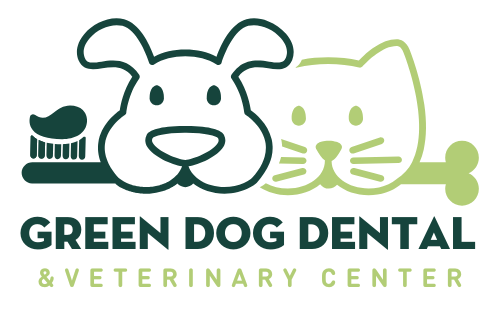
The Traditional Anesthetic Dental Cleaning service at Green Dog Veterinary Center is a gold standard in veterinary dentistry, ensuring a thorough cleaning and examination of your dog's oral health while they are under general anesthesia. This service is particularly essential for dogs with significant tartar buildup, gum disease, or those who require a more detailed examination and possible dental interventions, such as extractions or advanced gum treatments. Here's a detailed breakdown of what the service entails:
Preparation for Anesthesia: Before administering anesthesia, your dog will undergo a thorough pre-anesthetic evaluation, including a physical examination and rigorous blood screening to ensure they are in good health and to identify any potential risks associated with anesthesia. The veterinarian may also administer sedation to help your dog relax before the anesthesia is given.
Administration of Anesthesia: General anesthesia is administered to ensure your dog remains comfortable and still throughout the procedure, enabling a thorough examination and cleaning. An IV catheter may be placed to provide fluids, which help maintain proper circulation and stabilize your pet’s blood pressure during the procedure.
Comprehensive Dental Examination: Once under anesthesia, a comprehensive dental examination is conducted to check for signs of dental disease, including tartar, plaque, gum inflammation, loose or broken teeth, and other oral abnormalities. Dental radiographs (X-rays) may also be taken to evaluate the teeth and the bone structure below the gum line, providing a complete picture of your dog's dental health.
Dental Cleaning: The cleaning process involves the removal of tartar and plaque from both above and below the gum line, using specialized dental instruments. An ultrasonic scaler is often used to clean below the gum line, and a hand scaler may be used to remove tartar from the tooth surface.
Polishing: After the teeth have been cleaned, they are polished to smooth out any rough surfaces and to help prevent plaque and tartar buildup in the future. Some practitioners may also recommend the application of a sealant to keep your pet's teeth clean for longer and protect the enamel.
Additional Dental Procedures (if necessary): If any dental issues such as cavities, broken teeth, or gum disease are identified during the examination, additional procedures such as dental extractions or periodontal treatment may be performed, as recommended by the veterinarian and approved by the owner.
Recovery: After the procedure, your dog will be closely monitored as the effects of the anesthesia wear off, ensuring a safe recovery. Your dog will typically be ready to go home with you the same day.
Q&A:
Is anesthesia safe for my dog during dental cleaning?
Yes, anesthesia is generally considered safe for dogs during dental cleaning. A thorough pre-anesthetic evaluation is performed to identify any potential risks and ensure your dog is a good candidate for anesthesia.
What if my dog has a medical condition?
The veterinarian will assess your dog's overall health and any medical conditions before proceeding with anesthesia and dental cleaning. They may adjust the anesthetic protocol or recommend additional precautions based on your dog's health status.
How long does the Traditional Anesthetic Dental Cleaning take?
The procedure usually lasts between 45 to 75 minutes, depending on the existing dental condition, the number of X-rays, and the amount of tartar in the mouth.
Will my dog experience any pain during or after the procedure?
The use of anesthesia ensures that your dog does not experience pain during the procedure. Post-procedure discomfort may vary, and any pain is typically well-managed with medications as directed by the veterinarian.
How often should my dog have a Traditional Anesthetic Dental Cleaning?
The frequency of dental cleanings depends on your dog's individual dental health needs. It's essential to have regular veterinary check-ups to determine the appropriate dental care schedule for your dog.
